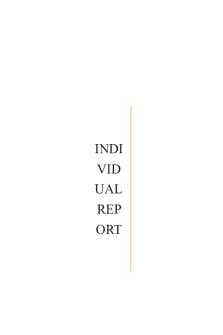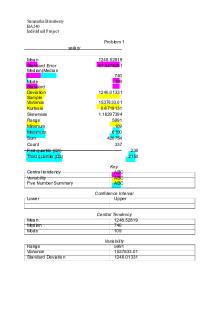BSC Easy Jet individual report PDF

| Title | BSC Easy Jet individual report |
|---|---|
| Course | Performance Measurement And Management |
| Institution | University of Strathclyde |
| Pages | 17 |
| File Size | 592.1 KB |
| File Type | |
| Total Downloads | 118 |
| Total Views | 153 |
Summary
Balanced scorecard report about Easy Jet...
Description
MS 929: Performance Measurement and Management
MSc Business Analysis and Consulting
The place of useful learning The University of Strathclyde is a charitable body, registered in Scotland, number SC015263
Table of Contents
Easy Jet key stakeholder analysis and stakeholder map ..........................................................................................3 Discussion and evaluation of the stakeholder map................................................................................................3 Development and justification of an Easy Jet strategy map ......................................................................................5 Evaluation of a Balanced Scorecard for Easy Jet and justification of KPIs ...............................................................8 Financial Perspective .............................................................................................................................................9 Customer Perspective ............................................................................................................................................9 Learning and Growth Perspective ........................................................................................................................10 Internal Perspective .............................................................................................................................................10 Practical issues that could arise for Easy Jet by the development of a BSC ..........................................................12 Appendices ..............................................................................................................................................................14 References...............................................................................................................................................................15
2
Easy Jet key stakeholder analysis and stakeholder map Stakeholders are vital contributors to company’s activities because of their significant interest and power that can either produce positive or negative outcomes. Additionally, as emphasized by Sokolova (2016), stakeholders have also the major ability to influence the uncertainty that firms are facing, therefore their importance should be acknowledged to minimise corporate risks. In addition, the understanding of stakeholder’s strategic positioning is crucial in determining the nature of the interdependency existing between stakeholders and firms (Steurer, 2006). As highlighted by Walker et al. (2008), once stakeholders are identified, a detailed analysis can be performed. In the case of Easy Jet, conducting stakeholder analysis will be beneficial to reveal the imbalance among different stakeholder groups and can be further used for a policy reform process. However, the aim here is to draw attention upon actors who have a significant interest in the strategic future of Easy Jet, while also considering the “powerless” groups (Eden and Ackermann, 1998). More specifically, stakeholder mapping needs to be conducted first through the utilisation of a power/interest matrix which will help to identify which groups are most useful to engage with. As discussed within the yearly report of Easy Jet (2016), the main stakeholders influencing the company are customers, suppliers, air traffic control, media, employees, airports, regulators and national governments. These stakeholders are classified within the power/interest matrix as an essential tool for any company because performance measurement can be later evaluated, based on stakeholders’ involvement level. Concerning Easy Jet’s performance, data from 2016 indicated that there was performance increase in digital sector meaning Easy Jet’s digital platforms have contributed to strong increase in number of visits from customers. In addition to the performance figures, there is 26.5% observed market share growth compared to 2015 (25.6%) based on short-haul flights. However, measures related to safety remain crucial to the airline’s performance (Easy Jet plc, 2016).
Discussion and evaluation of the stakeholder map As it can be seen from the matrix below, stakeholders with high power and low interest should be kept satisfied. This refers to governments and regulators such as Boeing and Airbus contractors, since their contribution to Easy Jet’s activities is significant where for example, the airline is required to conform to government’s policies, so that it can operate smoothly. On the other hand, air traffic control lies in the middle meaning they have roughly the same level of power and interest in the organisation. Moving forward, stakeholders (also referred as actors) within the quadrants of “manage closely” and “keep informed” are the ones with highest power to influence firm’s strategic future (Eden and Ackermann, 1998). Investors and more significantly the owner of Easy Jet shall be managed closely since they have high level of influence and interest. These stakeholders are also defined as “players” since they 3
deliberately act or support airline’s strategy, especially the main stakeholder Mr Haji-Ioannou owning 34.62% of Easy Group holding. He acts as a major contributor to company’s success, performance management and leadership planning. In addition, stakeholders in the bottom right quadrant are regarded as “context setters” who act as independent individuals having the ability to influence strategic situations without having stake in the company. Suppliers of Easy Jet can be classified within this quadrant with having greater interest in airline’s activities compared to customers, for instance. Media and the customers should be kept informed and they have weaker impact upon Easy Jet’s performance levels and strategy, compared to internal stakeholders. Crucial to consider is Easy Jet’s employees acting as shareholders. All employees can join Easy Jet’s “Save As You Earn” scheme, which allows them to save from money from their salary with the option to purchase shares (Easy Jet, 2018). Here it is essential to highlight that employees are highly likely to move their position within the stakeholder map. This is illustrated with the blue arrows on the matrix and can be observed by the direction of interest where Easy Jet employees can be grouped within the “keep informed” quadrant. This means they are characterised with having strong interest in the organisation’s activities but lower level of influence. However, this is subject to change and flexibility where employees have the specific power within Easy Jet to purchase shares. This will reposition them in the “manage closely” box where staff can be identified as “players” exerting greater power and impact within company’s strategic success. The same can be applied to the media as a stakeholder, since they can adjust their position towards the top right quadrant, regarded as “players”. This is very likely to happen due to the significant influence and interest the media has which can definitely affect Easy Jet’s brand image and reputation either positively or negatively. Lastly, local communities are classified as having relatively low interest and low power in airline’s activities and therefore should only be monitored with minimum effort. After allocating and analysing each stakeholder into the matrix below, it can be evaluated that more efficient decision-making and strategy planning can be performed for Easy Jet’s future actions. Additionally, the matrix can serve as an effective tool for collaboration between stakeholders based on their mutual company interests. However, in case when stakeholders’ attitudes and interests tend to vary, this cannot be fully examined just by plotting their position on the stakeholder map. Similarly, their attitudes or future intentions need to be examined using more in-depth analysis.
4
Figure 1: EasyJet stakeholder map
Development and justification of an Easy Jet strategy map Based on the performance indicators outlined in Easy Jet’s yearly report, the Kaplan and Norton method is chosen to classify airline’s strategies. This method is incorporated into a strategy map that will form the basis for the development of a balanced scorecard later on. As emphasized by Huang (2009, p.211), the application of a strategy map is beneficial to companies because it “describes the links between intangible assets and value creation”. In the case of Easy Jet, the use of such a map will link companyspecific objectives through a cause-and-effect relationship. Additionally, these objectives will be driven by the accomplishment of a major goal which is to generate profitability and sustainable growth for shareholders. Through the achievement of airline’s objectives, the company will successfully generate organisational capital and will enhance its’ competitive factor (Cokins, 2012). Furthermore, essential to highlight is that the development of the stakeholder map in the previous section has helped towards identifying the objectives of the strategy map. More specifically, the already defined stakeholders and their level of influence upon airline’s performance are useful for the allocation of objectives into the different perspectives (see Fig.2). For example, since the investors and the owner of 5
Easy Jet have high power and interest to manage closely the strategic actions of the airline, they will have also high level of influence upon the objectives within the financial perspective. Some of the key objectives included are the revenue growth, increasing competitive advantage and maintaining the strength of the company’s low-cost business model. Those strategic objectives will be crucial to the longterm success of the airline and will create a long-term vision for the airline growth. Most of the strategic objectives are defined by Easy Jet’s yearly report which focuses on the key performance indicators which will be later classified and linked to each of the objectives. Further, in order to keep maintaining the low-cost business model of Easy Jet, the improvement of customer satisfaction and loyalty need to be directly related. The customer satisfaction particularly is one of the main drives towards corporate success since the satisfaction is defined by the overall customer journey from the process of purchasing till the end of flight service. Moreover, customer satisfaction can be enhanced through investing in Easy Jet’s service quality and particularly with an emphasis on customers who need special assistance (Easy Jet, 2018). Interestingly, it was reported that there was an increase of 14% in providing service for passengers with disabilities on board where there was 83% satisfaction level for 2017. This is supported by the fact that Easy Jet continuously invests to support these individuals where recent implementations include on-board wheelchairs and accessible aircraft bathrooms. Additionally, the on-time performance improvement is another strategic priority which involves Easy Jet’s flights to meet the specified targets to arrive within 15 minutes of the scheduled flight. Besides, disruptions causing flight delays or cancellations due to strikes or weather conditions need to be decreased to a minimum, so that the airline can adhere to its’ strategic goals. These objectives (customer loyalty; satisfaction and performance improvement) align with the customer perspective illustrated below but also is defined by customer’s contribution emerging from the stakeholder map (Fig.1). This can be further explained by their relatively influential presence as stakeholders within the company who need to be kept informed about Easy Jet’s activities. Despite customers are not directly involved, they still exert indirect power since Easy Jet’s primary objective is to enhance customer satisfaction also through the continuous availability of affordable tickets, reliable and safe service. The airline effectively targets its’ audience through detailed research into consumer’s behaviour and service expectations, acting as critical success factors (Easy Jet, 2018). Specifically, through consumer’s evaluation and feedback, Easy Jet directs and adjusts its’ service offerings, in accordance with passenger’s requirements. Similarly, employees treated as stakeholders define the objectives presented within the internal perspective (Fig.2) on the strategy map. Their high level of interest and medium level of power contributes to investing more in staff training and reward scheme which will possibly retain the majority of skilled employees and they will have greater interest to remain with the company. Likewise, to recruit and retain the right people is the basis for the prior objective which will strengthen corporate’s strategic direction. Finally, since employees also have the power to buy shares from the organisation (discussed in stakeholder map section), the objective of continuous innovation and leadership is identified. This reflects Easy Jet’s 6
differentiation strategy in contrast with its’ competitors who rely predominantly on the cost-leadership factor as a major influencer. In line with the differentiation strategy, the investment into new technology and digital dependability aims to further improve the customer experience through the use of predictive analytics and website evaluation.
Figure 2: EasyJet strategy map
7
Evaluation of a Balanced Scorecard for Easy Jet and justification of KPIs In order to align with the main goal of increasing profitability and sustainable growth, it is crucial for the management team of Easy Jet to design a tool that addresses key performance measures. These specific measures aim to positively impact the strategic control of the business (Wisniewski and Olafsson, 2004). This is utilised through key objectives extracted from the strategy map which are evaluated towards their corresponding key performance indicators (KPIs). As evident from the strategy map (Fig.2), more KPIs are identified, compared to the ones available on Fig.4, where KPIs are defined as required actions towards achieving the strategic objectives (Kaplan, 2008). Once these are classified and allocated across the 4 performance perspectives, a balanced scorecard is produced which outlines a framework towards maintaining successful business model of Easy Jet. Initially developed by Kaplan and Norton (1992), the BSC is a valuable management system which is used by businesses to clarify and translate their strategies into execution (Divandri and Yousefi, 2011). As outlined by Wisniewski (1998, p.4), the scorecard has another major purpose to “provide managers with a comprehensive, but timely, view of an organisation’s performance”. Additionally, the BSC framework consists of four management processes that, “separately and in combination, help link long-term strategic objectives with short-term actions” (Huang, 2009, p.211).
Adapted from Wisniewski (1998), on the right-hand side there is an explanation of questions necessary for satisfying the different perspectives. Applying these to Easy Jet, it needs to be stressed that there is no ideal number for choosing KPIs. However, the most efficient way when deciding which KPIs to exclude from the strategy map is to refer to the financial report of the airline. That is how the most valuable and reliable objectives were identified and balanced as well. Clear interdependence can be also seen from the strategy map since relevant objectives were initially linked to the four perspectives necessary later for the scorecard.
Figure 3: Performance perspectives
8
Financial Perspective Concerning the financial perspective, only one KPI which aligns with an already existing one, has been identified. This refers to the “grow revenue” objective which was discussed within the yearly report of Easy Jet (2016). It can be measured by examining “revenue per seat” which represents the “revenue per user” as most closely matching the KPI description provided by Marr (2018). Within the report context, this KPI is characterised with a decrease of 6.9% “at constant currency due to the impact from terrorismrelated events” (Easy Jet plc, 2016, p.16). Additional contributors to the decrease of seat revenue are the relatively low prices in the oil and gas industry but also the more expensive Euro rates for British travellers, especially after the Brexit issue. Overall, the revenue per user KPI is crucial for the airline because it needs to monitor the fluctuations in accordance with the market. Besides, this will help to adjust the pricing strategy that will be more comparable with rival airlines such as Ryan Air and Wizz Air. The reason why the remaining two financial objectives were not identified with any of the KPIs already provided, is because of the specificity of these objectives. As a low-cost carrier, it is essential for Easy Jet to maintain its’ low-cost business model and lean cost advantage. This is measured through efficient predictive analytics which help to track consumer’s behaviour but also to identify the evaluation according to different scenarios for lowering operational costs. Overall, the financial perspective will help towards measuring the significance of each stakeholder as well, where through the applied measures (KPIs) performance uncertainty will be decreased and in turn will form stable basis for planning and control (Bernard and Neely, 2003).
Customer Perspective Regarding the customer perspective, all three objectives from the strategy map are selected due to their high relevance and importance within Easy Jet’s strategic actions. Two already identified KPIs were recognised, since they are common ones within other companies. For example, the customer loyalty factor is directly recognised with its corresponding KPI of customer retention rate (Marr, 2018). Similarly, customer satisfaction is major contributor to the firm’s strategic success and progress. The level of satisfaction across consumers can be enhanced firstly by providing competitive ticket prices, but also value for money which is promoted by airline’s collaboration with its’ associated partners like Easy package holidays. The data for 2016 revealed that the customer’s satisfaction with their recent flights decreased compared to previous years (72%). It can be evaluated that this was caused by travel disruption caused by external factors such as airline strikes or adverse weather conditions (Easy Jet, 2016). However, the abovementioned objective can be accomplished through improvement of the gaps in the customer experience but also through investment in services that support customers needing special assistance. Therefore, a KPI of SERVQUAL is identified as a proper one (Marr, 2018) which will aim to measure Easy Jet’s service quality. This survey type will also effectively fill in the gap between the service level customers expect and their actual view of the service (Carlson and O’ Cass, 2011). In 9
addition, the on-time performance improvement needs to be collaborated with the Air traffic control stakeholders who will assess the punctuality of the flights where disruption for passengers will aim to be decreased to a minimum. A new KPI is suggested for this particular objective (optimise flight punctuality) since it is again specific to the airline. It is paramount that this KPI is accomplished through measuring the percentage of flights on “schedule with an analysis of delayed flights by reason - distinguishing unavoidable and avoidable delays. The latter will indicate the areas where management action needs to be directed to improve performance” (Morgan, 2016).
Learning and Growth Perspective On the other side, the learning and growth perspective captures the “ability of employees, information systems, and organizational alignment to manage a business and adapt to change” (Huang 2009, p.211). The increase of environmental sustainability is aligned with the KPI of carbon footprint (Marr, 2018). More specifically, to cut more carbon emissions is within the core aspects to consider towards Easy Jet’s greener future. This KPI can be extre...
Similar Free PDFs

BSC Easy Jet individual report
- 17 Pages

MKT 479 Easy jet strategy analysis
- 19 Pages

Cas Easyjet - CAS TEMA 1 EASY JET
- 15 Pages

Individual Report
- 14 Pages

Simnetics - BSC - BSC
- 25 Pages

ACCG1001 Individual Report
- 6 Pages

BUS303 Individual Project Report
- 23 Pages

Individual Report- Edumondo
- 7 Pages

Report - Assignment 2 : Individual
- 11 Pages

BA240 Individual Report Brimb
- 6 Pages

Individual Report Walmart
- 7 Pages

Individual Report - 2
- 3 Pages

Individual Report - Marketing Audit
- 20 Pages

Individual Market View Report
- 7 Pages
Popular Institutions
- Tinajero National High School - Annex
- Politeknik Caltex Riau
- Yokohama City University
- SGT University
- University of Al-Qadisiyah
- Divine Word College of Vigan
- Techniek College Rotterdam
- Universidade de Santiago
- Universiti Teknologi MARA Cawangan Johor Kampus Pasir Gudang
- Poltekkes Kemenkes Yogyakarta
- Baguio City National High School
- Colegio san marcos
- preparatoria uno
- Centro de Bachillerato Tecnológico Industrial y de Servicios No. 107
- Dalian Maritime University
- Quang Trung Secondary School
- Colegio Tecnológico en Informática
- Corporación Regional de Educación Superior
- Grupo CEDVA
- Dar Al Uloom University
- Centro de Estudios Preuniversitarios de la Universidad Nacional de Ingeniería
- 上智大学
- Aakash International School, Nuna Majara
- San Felipe Neri Catholic School
- Kang Chiao International School - New Taipei City
- Misamis Occidental National High School
- Institución Educativa Escuela Normal Juan Ladrilleros
- Kolehiyo ng Pantukan
- Batanes State College
- Instituto Continental
- Sekolah Menengah Kejuruan Kesehatan Kaltara (Tarakan)
- Colegio de La Inmaculada Concepcion - Cebu

